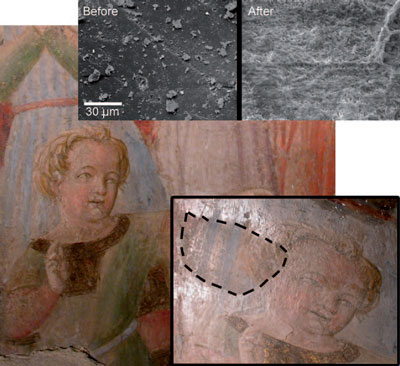| Posted: Oct 26, 2009 | |
As good as new - nanotechnology art conservation |
|
| (Nanowerk Spotlight) A couple of years ago we reported on applications of nanotechnology-based processes to the restoration and preservation of priceless artwork ("Nanotechnology saves Renaissance masterpieces, Mayan wall paintings, and old shipwrecks"). Researchers have shown that nanodispersions of solids, micelle solutions, gels and microemulsions offer new reliable ways to restore and preserve works of art by merging together the main features and properties of soft-matter and hard-matter systems, allowing the synthesis of systems specifically tailored for the works of art to fight the deterioration processes which threaten many priceless masterpieces. | |
| Researchers at the University of Florence, who have been leading efforts to apply nanoparticle-based cleaning agents for artwork, have now further developed their work by exploring the design of novel systems containing low amounts of volatile oils as low-impact cleaning tools for the removal of aged polymeric coatings from the surface of paintings. | |
 |
|
| Detail of the wall painting (Santa Maria della Scala Sacristy, Siena, Italy) on which the removal of poly(ethylmethacrylate-co-methylacrylate) with the microemulsion embedded in the hmHEC system was tested. Bottom right: grazing-light photograph of part of the painting after the application of the cleaning system (see the region within the dashed line). Top: SEM images before and after polymer removal. (Reprinted with permission from Wiley-VCH Verlag) | |
| "Nowadays, one of the most important problems faced during the cleaning of works of art is the removal of organic materials, mainly acrylic polymers, applied in the past as consolidants or protective coatings," explains Piero Baglioni, a professor of Physical Chemistry at the University of Florence. "Unfortunately, their application induces a drastic alteration of the interfacial properties of the artwork and leads to increased degradation. These organic materials must therefore be removed." | |
| The solution developed by Baglioni and his team has been to develop a micro-emulsion cleaning agent that is designed to dissolve only the organic molecules on the surface of a painting or other artwork. This emulsion is not only suitable for removing the aged coating on paintings but also for the removal of aged organic varnishes from the surface of easel paintings or gilded surfaces, as an alternative to gels traditionally used in conservation. | |
| The cleaning agent is made by dissolving the volatile solvent p-xylene in water and thickening it into a gel with hydrophobically modified hydroxyethylcellulose (hmHEC) – a gelling and thickening agent derived from cellulose. This oil-in-water emulsion has a microstructure of tiny droplets of oil-coated water trapped in the cellulose chains, and these will dissolve organic polymers on the painting's surface, thereby restoring the original, clean finish. | |
| According to the Italian team, the efficacy of this system as a cleaning tool relies on the presence of nanodroplets confined in the hmHEC network, resulting in a method that is simpler and less invasive than traditional methods. | |
| The team has reported their findings in the October 15, 2009 online issue of Angewandte Chemie International edition ("Nanoscience for Art Conservation: Oil-in-Water Microemulsions Embedded in a Polymeric Network for the Cleaning of Works of Art") | |
| Testing their cleaner on 15th century wall paintings in a church in Siena, the Italian researchers conclude that microemulsions embedded in an aqueous polymeric network enable the complete removal of an aged layer of acrylic polymer previously used in conservation at works of art. Consequently, these emulsions promise to become highly effective low-impact cleaning agents for works of art. | |
| "Microemulsions embedded in aqueous polymeric networks combine the main advantages of oil-in-water microemulsion systems – a decrease in environmental impact owing to minimization of the quantity of the organic solvent and enhancement of detergency – with the versatility of polymer-solution technology and straightforward manipulation of the material" says Baglioni. "A further advantage offered by our approach is the broad field of application: for the first time the application of water-based cleaning systems has proved to be effective for the removal of organic materials from both wall-painting and easel-painting surfaces." | |
 By
Michael
Berger
– Michael is author of three books by the Royal Society of Chemistry:
Nano-Society: Pushing the Boundaries of Technology,
Nanotechnology: The Future is Tiny, and
Nanoengineering: The Skills and Tools Making Technology Invisible
Copyright ©
Nanowerk LLC
By
Michael
Berger
– Michael is author of three books by the Royal Society of Chemistry:
Nano-Society: Pushing the Boundaries of Technology,
Nanotechnology: The Future is Tiny, and
Nanoengineering: The Skills and Tools Making Technology Invisible
Copyright ©
Nanowerk LLC
|
|
|
Become a Spotlight guest author! Join our large and growing group of guest contributors. Have you just published a scientific paper or have other exciting developments to share with the nanotechnology community? Here is how to publish on nanowerk.com. |
|
